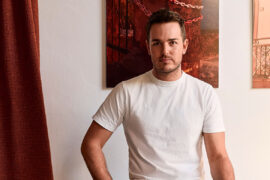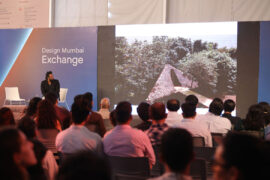When Luke Pearson and Tom Lloyd founded their eponymous studio, PearsonLloyd, in 1997 they set out to bring the worlds of furniture design and industrial production closer together – an approach that has brought them success as one of the world’s most celebrated design studios.
Two decades ago, a pair of recent design graduates from London’s Royal College of the Arts would meet to drink beer and discuss the duality of the design world. One of them had studied industrial design before completing a masters in furniture design, while the other did the opposite, and they were intrigued by the differences, and similarities, between furniture and industrial product design.
Today, that duo – Luke Pearson and Tom Lloyd – are pursuing that same discourse at the helm of PearsonLloyd, one of the UK’s most celebrated design studios. “We had an ambition to mix those two worlds in a way that hadn’t previously been done, except perhaps by the Italian architects of the 1950s,” says Pearson.
“And today,” says Lloyd, “that mix is still absolutely as we dreamt about it twenty years ago.” PearsonLloyd began designing furniture – for the likes of Walter Knoll and Bene – but with an approach that was distinctly informed by industrial design practice and its focus on the client relationship and end-user.
“A recognisable fingerprint has never been our main goal,” says Pearson. “We’d like it to be somewhat undercover and camouflaged.” So, while they may have worked on numerous successful projects with global reach, there are few that are instantly recognisable as the work of the pair – perhaps the studio’s most distinguishing feature.
“There has to be a ballet between the client’s DNA and your own DNA as a designer,” says Lloyd. “But, we love that our work is celebrated through our collaborations. It’s a bit like playing tennis. Rafa Nadal can’t be a great tennis player without someone on the other side of the net.”
With this approach – which was unusual during the late 1990s, the heyday of superstar designers with their idiosyncratic style – it wasn’t long before the studio transitioned from furniture design with an industrial design bent to industrial design with the aesthetic sensitivities of the furniture world. In 2001, aviation giant Virgin Atlantic approached PearsonLloyd to design their upper-class seats.
“That was the first time that we really got a sense that our approach might work,” says Lloyd. Taking this approach even further, the studio began to work on service projects, for which there wasn’t necessarily a physical solution to the design problem. Take the much-publicised A Better A&E project from 2011, which reduced aggressive behaviour in hospital emergency rooms by fifty per cent simply by changing the way patients were provided information about their experience.
Or, the pair’s recent work with InterContinental Hotels Group – they designed a strategy to re-think the hotel room based on current work trends, but the actual physical spaces were designed by local designers who implemented the strategy.
“Design at its best has always dealt with these complexities,” says Pearson. “At its simplest, it is an individual craft expression. At its most complex, it deals with systems and how those systems work with and for people.”
The most rewarding projects, however, are those that are both these things. Parcs for Bene, for example, is not only a beautiful collection of functional furniture for the workplace but also represented a massive shift in the way people worked and how organisations engaged with workplace design strategically when it launched in 2009.
“It was very timely,” says Pearson. “We thought it was going to be a disaster but its strength was that it was forward-thinking. Because of the crash, everyone had to radically re-think their work style – Parcs was perfect, and it quickly became a market-leading product.”
Not only is the studio’s work relevant – take the Intelligent Waste collection for Joseph Joseph, which elevates the relatively modern act of recycling in the home – but it is inherently thoughtful. Looking through the pair’s portfolio, there is the sense that they only work on projects that they feel contribute to bettering the world – whether in a large or small way.
“When we started the studio, there were 3.7 billion people on the planet,” says Pearson. “Today, there is double that. What we do becomes more relevant as we, as humans, make it easier, cheaper and faster to do things. It’s exciting because, as we get older, we can use our experience to help companies develop things intelligently and thoughtfully – that’s something that we both look forward to.”
INDESIGN is on instagram
Follow @indesignlive
A searchable and comprehensive guide for specifying leading products and their suppliers
Keep up to date with the latest and greatest from our industry BFF's!

From the spark of an idea on the page to the launch of new pieces in a showroom is a journey every aspiring industrial and furnishing designer imagines making.

At the Munarra Centre for Regional Excellence on Yorta Yorta Country in Victoria, ARM Architecture and Milliken use PrintWorks™ technology to translate First Nations narratives into a layered, community-led floorscape.

Merging two hotel identities in one landmark development, Hotel Indigo and Holiday Inn Little Collins capture the spirit of Melbourne through Buchan’s narrative-driven design – elevated by GROHE’s signature craftsmanship.

From furniture and homewares to lighting, Dirk du Toit’s Melbourne-based studio Dutoit is built on local manufacturing, material restraint and the belief that longevity is central to sustainable design.

Design Mumbai has concluded its second edition, reinforcing its position as India’s leading international showcase for contemporary design.
The internet never sleeps! Here's the stuff you might have missed

Former INDE Luminary LeAmon joins the Design Institute of Australia (DIA) following more than a decade as the inaugural Curator of Contemporary Design and Architecture at the National Gallery of Victoria (NGV).

Indesign Media is aware of recent reports raising serious concerns about Australian architectural photographer Derek Swalwell.